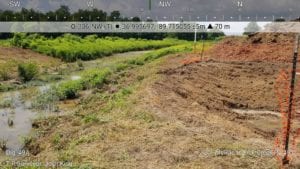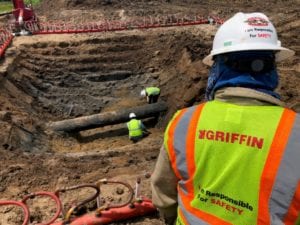Project Name: Dewatering during Pipeline Repair Project
Project Location: Vanduser, Missouri
Owner: Enterprise Products
GC: Enerpipe LTD
Project Revenue: $66,450.00
Project Timeline: July 2018
Summary:
Dewatering around an existing pipeline during a Pipeline Repair Project in Missouri.

The Challenge:
The contractor could not continue the pipeline repair project due to running into groundwater only 7 feet (ft.) below ground surface. The water had to be drawn down to over 16 ft. for welding to occur underneath the pipe. The completion of Griffin’s dewatering work was essential in finishing this project.

As with most pipeline repair dewatering projects, the soil information and volume of water was unknown. To be prepared for the volume of water that we could encounter, Griffin brought an extra pump to double the dewatering capacity, if required. As it turned out, the second pump was needed to successfully complete this project.

The Solution:
The groundwater was at 7 ft. below grade and needed to be drawn down to 16 ft., including the 2 ft. needed for welding below the pipe. Griffin provided 280 linear ft. of wellpoint dewatering around the perimeter of the open-cut 60×60 ft. excavation. We installed 140 wellpoints on very close spacing (2 ft. centers), using track punch jetting. To accommodate the high flow rate that was expected we utilized two (2) 6-inch diesel wellpoint pumps with one (1) standby pump, to maintain drawdown throughout the project.

The Griffin Difference:
With no available information on the soil or groundwater levels, Griffin’s experience in the area and with similar projects was key. This experience allowed us to design a system that could provide consistent dewatering results to keep the project on schedule
Griffin’s equipment availability allowed us to react quickly to the client’s needs. The project was successfully completed with a negligible impact to the overall schedule.